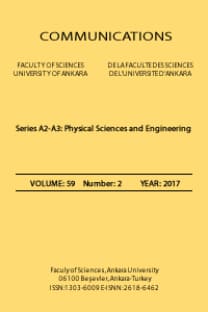Utilization of deep learning architectures for MIMO detection
Utilization of deep learning architectures for MIMO detection
___
- Yang, S., Hanzo, L., Fifty years of MIMO detection: The road to large-scale MIMOs, IEEE Comm. Surv. Tutor., 17 (4) (2015), 1941-1988, https://doi.org/10.1109/COMST.2015.2475242.
- Albreem, M.A., Juntti, M., Shahabuddin, S., Massive MIMO detection techniques: A Survey, IEEE Comm. Surv. Tutor., 21 (4) (2019), 3109-3132, https://doi.org/10.1109/COMST.2019.2935810.
- Wei, Y., Zhao, M-M., Hong, M., Zhao, M-J., Lei, M., Learned conjugate gradient descent network for Massive MIMO detection, IEEE Trans. Signal Process., 68 (2020), 6336- 6349, https://doi.org/10.1109/TSP.2020.3035832.
- Dai, L., Gao, X., Su, X., Han, S., I, C-L., Wang, Z., Low complexity soft-output signal detection based on Gauss-Seidel method for uplink multiuser large-scale MIMO systems, IEEE Trans. Veh. Technol., 64 (10) (2015), 4839-4845, https://doi.org/10.1109/TVT.2014.2370106.
- Yu, A., Jing, S., Tan, X., Wu, Z. Yan, Z., Zhang, Z., You, X., Zhang, C., Efficient successive over relaxation detectors for massive MIMO, IEEE Trans. Circuits Syst. I: Regul. Pap., 67 (6) (2020), 2128-2139, https://doi.org/10.1109/TCSI.2020.2966318.
- LeCun, Y., Bengio, Y., Hinton, G., Deep learning, Nature, 521 (2015), 436-444, https://doi.org/10.1038/nature14539.
- Zhang, J., He, Y., Li, Y-W., Wen, C-K., Jin, S., Meta learning-based MIMO detectors: Design, simulation, and experimental test, IEEE Trans. Wirel. Commun., 20 (2) (2021), 1122-1137, https://doi.org/10.1109/TWC.2020.3030882.
- Albreem, M.A., Alhabbash, A.H., Shahabuddin, S., Juntti, M., Deep learning for massive uplink detectors, IEEE Comm. Surv. Tutor., vol. 24, no. 1, (2022), 741-766, https://doi.org/10.1109/COMST.2021.3135542.
- Hershey, J.R., Roux, J.L., Weninger, F., Deep unfolding: Model-based inspiration of novel deep architectures, arXiv: 1409.2574, (2014), https://doi.org/10.48550/arXiv.1409.2574.
- Balatsoukas-Stimming, A., Studer, C., Deep unfolding for communication systems: A survey and some new directions, 2019 IEEE International Workshop on Signal Processing Systems (SiPS), (2019), 20-23 October 2019, 266-271, Nanjing, China, https://doi.org/10.1109/SiPS47522.2019.9020494.
- Liao, J., Zhao, J., Gao, F., Li, G.Y., A model-driven deep learning method for massive MIMO detection, IEEE Commun. Lett., vol. 24, no. 8, (2020), 1724-1728, https://doi.org/10.1109/LCOMM.2020.2989672.
- He, H., Wen, C-K., Jin, S., L, G.Y., A model-driven deep learning network for MIMO detection, 2018 IEEE Global Conference on Signal and Information Processing (GlobalSIP), (2018), 26-29 November 2018, 584-588, Anaheim, CA, USA, https://doi.org/10.1109/GlobalSIP.2018.8646357.
- O’Shea, T.J., Erpek, T., Clancy, T.C., Deep learning-based MIMO communications, arXiv: 1707.07980, (2017), https://doi.org/10.48550/arXiv.1707.07980.
- Samuel N., Diskin, T., Wiesel, A., Learning to detect, IEEE Trans. Signal Process., 67 (10), (2019), 2554-2564, https://doi.org/10.1109/TSP.2019.2899805.
- Baek, M-S., Kwak, S., Jung, J-Y., Kim, H.M., Choi, D-J., Implementation methodologies of deep learning-based signal detection for conventional MIMO transmitters, IEEE Trans. Broadcast., 65(3), (2019), 636-642, https://doi.org/10.1109/TBC.2019.2891051.
- Chen, Q., Zhang, S., Xu, S., Cao, S., Efficient MIMO detection with imperfect channel knowledge – A deep learning approach, 2019 IEEE Wireless Communications and Networking Conference (WCNC), (2019), 15-18 April 2019, 1-6, Marakkesh, Morocco, https://doi.org/10.1109/WCNC.2019.8885582.
- Corlay, V., Boutros, J.J., Ciblat, P., Brunel, L., Multilevel MIMO detection with deep learning, 2018 52nd Asilomar Conference on Signals, Systems, and Computers, (2018), 28-31 October 2018, 1805-1809, Pacific Grove, CA, USA, https://doi.org/10.1109/ACSSC.2018.8645519.
- Poudel, B., Oshima, J., Kobayashi, H., Iwashita, K., MIMO detection using a deep learning neural network in a mode division multiplexing optical transmission system, Opt. Commun., 440 (2019), 41-48, https://doi.org/10.1016/j.optcom.2019.02.016.
- Lin, C., Chang, Q., Li, X., A deep learning approach for MIMO-NOMA downlink signal detection, Sensors, 19 (2526) (2019), https://doi.org/10.3390/s19112526.
- Sun, J., Zhang, Y., Xue, J., Xu, Z., Learning to search for MIMO detection, IEEE Trans. Wirel. Commun., 19 (11) (2020), 7571-7584, https://doi.org/10.1109/TWC.2020.3012785.
- Zappone, A., Renzo, M.D., Debbah, M., Wireless network design in the era of deep learning: Model-based, AI-based, or both?, IEEE Trans. Commun., 67 (10) (2019), 7331- 7376, https://doi.org/10.1109/TCOMM.2019.2924010
- ISSN: 1303-6009
- Yayın Aralığı: Yılda 2 Sayı
- Başlangıç: 2019
- Yayıncı: Ankara Üniversitesi
Utilization of deep learning architectures for MIMO detection
Sümeye Nur KARAHAN, Aykut KALAYCIOĞLU
A study on modeling growth model of Adana pigeons
A method for analyzing suspect-filler similarity using convolutional neural networks
Evaluation of the impact of I/Q imbalance compensation on communication performance
Gizem Eda SAĞIR, Selçuk TAŞCIOĞLU
Design and implementation of a microcontroller based split air conditioner control system
Determination of the surface topography in rill erosion by imaging techniques
